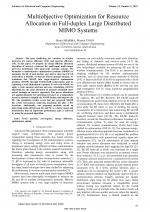| 2/2021 - 8 |
Multiobjective Optimization for Resource Allocation in Full-duplex Large Distributed MIMO SystemsSHARMA, S. |
| Extra paper information in |
| Click to see author's profile in |
| Download PDF |
Author keywords
antenna, convergence, energy efficiency, optimization, uplink
References keywords
energy(34), efficiency(23), systems(20), mimo(14), efficient(14), networks(13), multi(12), distributed(12), optimization(11), spectral(10)
Blue keywords are present in both the references section and the paper title.
About this article
Date of Publication: 2021-05-31
Volume 21, Issue 2, Year 2021, On page(s): 67 - 74
ISSN: 1582-7445, e-ISSN: 1844-7600
Digital Object Identifier: 10.4316/AECE.2021.02008
Web of Science Accession Number: 000657126200008
SCOPUS ID: 85112806037
Abstract
The most conflicting key variables in wireless networks are energy efficiency (EE) and spectral efficiency (SE). In this paper, we propose an energy-efficient allocation algorithm of network resources for multi-input multi-output networks distributed with large-scale antenna systems. We formulate a multiobjective optimization problem (MOOP) to maximize the EE of each distinct user and to show the EESE trade-off as a MOOP. To find the Pareto optimal solution, we transform this MOOP into single-objective optimization problem (SOOP) through Tchebycheff scalarization and by exploiting it with Dinkelbach's method. To solve the SOOP, we apply a joint antenna selection and user scheduling (JASUS) algorithm for the joint allocation of antenna scheduled users solved through an iterative approach. The power allocations are applied distinctly for individual cell users by a subgradient iterative method to simplify the SOOP further and improve the EE. The simulation results reveal that our proposed MOOP has a fast convergence, achieving maximum EE after a few iterations. Additionally, our proposed methods unveil an interesting trade-off between EE and SE at a faster speed and demonstrate that an important performance gain is achieved by using the proposed algorithm. |
| References | | | Cited By |
Web of Science® Times Cited: 1 [View]
View record in Web of Science® [View]
View Related Records® [View]
Updated 6 days, 6 hours ago
SCOPUS® Times Cited: 3
View record in SCOPUS® [Free preview]
View citations in SCOPUS® [Free preview]
[1] Building an Adaptive Cooperative Transmission Mechanism for Multimedia Convergence System, Su, Ming-Kai, Lin, Jia-Yi, Horng, Gwo-Jiun, Aripriharta, Aripriharta, Chen, Chao-Chun, Wireless Personal Communications, ISSN 0929-6212, Issue 4, Volume 133, 2023.
Digital Object Identifier: 10.1007/s11277-024-10865-2 [CrossRef]
Disclaimer: All information displayed above was retrieved by using remote connections to respective databases. For the best user experience, we update all data by using background processes, and use caches in order to reduce the load on the servers we retrieve the information from. As we have no control on the availability of the database servers and sometimes the Internet connectivity may be affected, we do not guarantee the information is correct or complete. For the most accurate data, please always consult the database sites directly. Some external links require authentication or an institutional subscription.
Web of Science® is a registered trademark of Clarivate Analytics, Scopus® is a registered trademark of Elsevier B.V., other product names, company names, brand names, trademarks and logos are the property of their respective owners.
Faculty of Electrical Engineering and Computer Science
Stefan cel Mare University of Suceava, Romania
All rights reserved: Advances in Electrical and Computer Engineering is a registered trademark of the Stefan cel Mare University of Suceava. No part of this publication may be reproduced, stored in a retrieval system, photocopied, recorded or archived, without the written permission from the Editor. When authors submit their papers for publication, they agree that the copyright for their article be transferred to the Faculty of Electrical Engineering and Computer Science, Stefan cel Mare University of Suceava, Romania, if and only if the articles are accepted for publication. The copyright covers the exclusive rights to reproduce and distribute the article, including reprints and translations.
Permission for other use: The copyright owner's consent does not extend to copying for general distribution, for promotion, for creating new works, or for resale. Specific written permission must be obtained from the Editor for such copying. Direct linking to files hosted on this website is strictly prohibited.
Disclaimer: Whilst every effort is made by the publishers and editorial board to see that no inaccurate or misleading data, opinions or statements appear in this journal, they wish to make it clear that all information and opinions formulated in the articles, as well as linguistic accuracy, are the sole responsibility of the author.



